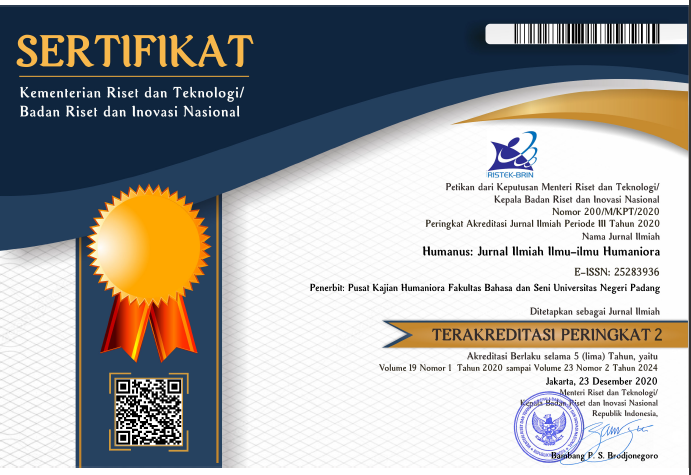The Meaning of Kadyatmikan in the Tutur Tegesing Wisik Warah Text: A Study of Cultural Semiotics
 ), Ida Bagus Rai Putra(2), Luh Putu Laksminy(3),
), Ida Bagus Rai Putra(2), Luh Putu Laksminy(3), (1) Universitas Udayana
(2) Universitas Udayana
(3) Universitas Udayana
 Corresponding Author
Corresponding Author
Copyright (c) 2025 Ida Bagus Pradnyana Mahardika
DOI : https://doi.org/10.24036/humanus.v24i1.131583
Full Text:
 Language : en
Language : en
Abstract
Kadyatmikan, a core aspect of Balinese spiritual teachings, is a secondary modeling system that offers guidance toward spiritual balance and moksa (liberation) through practices such as self-control, meditation, and harmony with nature. This study investigates the meaning of Kadyatmikan in the Tutur Tegesing Wisik Warah text, through Yuri Lotman's (1990) cultural semiotics framework. Using a descriptive qualitative method, this research identified and analyzed the symbolic elements and spiritual codes within the text. A heuristic reading method was applied to uncover surface-level meanings, such as narrative structures and linguistic features, and connotative reading to explore deeper symbolic and cultural interpretations. The analysis focused on the interaction of these elements with the Balinese cultural semiosphere. The findings highlight the symbolic relevance of teachings like Sad Ripu and Yoga (meditative practices), demonstrating their role in fostering self-realization and cultural identity. Discussion emphasizes the dual function of these teachings: preserving Balinese spiritual values and addressing contemporary challenges through cultural adaptability. The research contributes to empirical studies of cultural semiotics and conceptual explorations of traditional wisdom in modern contexts
Keywords
References
Asriningsari, A., & Umaya, N. (2010). Semiotics: Theory and application in literary works. Semarang: UPGRIS Press.
Astuti, T., Suhardjono, DW, & Murtini. (2022). The crisis of modern women's search for identity: Searching for lost women (a review of Yuri Lotman's cultural semiotics). Pena Literasi, 5(1), 100-110.
Dharmayanti, IAIA, Suarka, IN, & Putra, IBR (2019). The meaning of pujasmara in Kakawin Hañang Nirartha. Linguistics, 26(1), 27-36.
Sumbaga, MF (2022). Stress management: Healthy mind, healthy communication with the application of mindfulness. Devotion: Journal of Psychological Service, 1(02), 81-88.
Hasanah, U. (2022). Analisis semiotik pada novel Pulang karya Leila S. Chudori: Kajian teori Yuri Lotman (Doctoral dissertation, STKIP PGRI Bangkalan).
Hidayati, N., Aryanti, IP, Salim, S., Zuliani, YE, & Yusuf, AH (2019). The use of mindfulness meditation in stress management: A systematic review. Journal of Health Research, 9(2), 95-100.
Jalu, Putra N. I. (2019). Cultural signs in the short story Filosofi Kopi by Dee Lestari: A semiotic analysis of Jurij Lotman's cultural semiotics. Jurnal Skripta, 5(1), 32-40.
Kaelan. (2017). Philosophy of Language, Semiotics and Hermeneutic. Yogyakarta: Paradigma Yogyakarta.
Lantowa, J., Marahayu, NM, & Khairussibyan, M. (2017). Semiotics: Theory, methods, and their application in literary research. Yogyakarta: Deepublish.
Lotman, Y. (1977). The structure of the artistic text. Michigan: University of Michigan.
Lotman, Y. (1990). Universe of the mind: A semiotic theory of culture (A. Shukman, Trans.). Bloomington: Indiana University Press.
Manggala, IMS, Suarka, IN, & Putra, IBR (2022). The meaning of Djawi Wisnu Buddhist theology in the Weddo Djojo Sampurno Book. Journal of Hindu Religious Research, 6(3), 201-211.
Maier, H. (1982). The failure of a hero: An analysis of Pramoedya Ananta Toer's short story Sunat. Bijdragen tot de Taal-, Land- en Volkenkunde, 138(3), 317-345.
Nöth, W. (2006). Yuri Lotman on metaphors and culture as self-referential semiospheres. Semiotica, 2006(161), 249-263.
Rahayu, I. S. (2021). Analysis of semiotic study in Chairil Anwar's poetry using Charles Sanders Peirce's theory. Jurnal Semiotika, 15(1), 30-36.
Rahayu, T. P. (2022). Roland Barthes' reading codes in the short story Pemintal Kegelapan by Intan Paramaditha: A semiotic study. Jurnal Ilmiah Fonema, 5(1), 40-52.
Sangkaryang, D., Cika, IW, & Jirnaya, IK (2022). Metta discourse in Kakawin Ananda Bhuwana. Journal of Arts and Humanities, 26(3), 226-240.
Pratiwi, SNK (2022). Dasa Dharma learning method as an implementation of holistic education. Metta: Journal of Multidisciplinary Science, 2(3), 133-145.
Suyanta, IW, Sugata, IM, Adi Brahman, IM, Juniartha, MG, & Alit Nuriawan, IN (2024). The structure of ancient Balinese yoga according to the UHN I Gusti Bagus Sugriwa Denpasar: A philosophical and practical study. Journal of Hindu Religious Research, 8(3), 286-304.
Wicaksono, RA, Hidayat, RR, & Makhmudah, U. (2021). Literature study of the application of mindfulness theory to reduce academic stress. Journal of Psychoeducation and Counseling, 5(2), 88-99.
Zoetmulder, P. J. (1995). Old Javanese-Indonesian Dictionary. Jakarta: PT Gramedia Pustaka.
Manuscript Source: Lontar Tutur Tutur Tegesing Wisik Warah, collection of the Bali Provincial Cultural Service Office, Denpasar, manuscript number, T/I/2/DOKBUD.
 Article Metrics
Article Metrics
 Abstract Views : 58 times
Abstract Views : 58 times
 PDF Downloaded : 25 times
PDF Downloaded : 25 times
Refbacks
- There are currently no refbacks.
Copyright (c) 2025 Ida Bagus Pradnyana Mahardika

This work is licensed under a Creative Commons Attribution-NonCommercial 4.0 International License.











